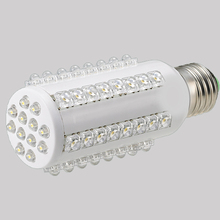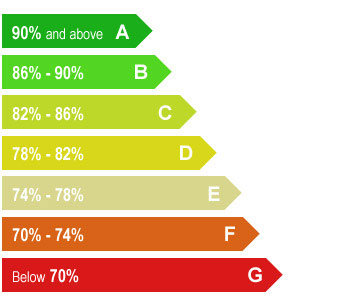- Joined
- 27 Jan 2008
- Messages
- 27,760
- Reaction score
- 3,365
- Location
- Llanfair Caereinion, Nr Welshpool
- Country

I have a folded fluorescent lamp 11W above my computer is a table lamp the lumen per what is about the same as for my LED lamps however it does not mean all LED or all fluorescent will produce 100 lumen for 1.4W the light output varies rather a lot.
The GU10 is a silly spot light but great for reading lamps so use them in bed room and in table lamps. I looked into these bulbs and also the 12 volt version GU5.3 and it would seem with the 230 volt version a switch mode power supply is used to reduce the voltage to around 3 volt needed for a LED. But with the 12 volt version often this is not the case and a simple resistor is used. If you look at the GU10 it is limited how many LED's can be used in the bulb as having 80 LED's in series and simple resistor is not an option.
Look at this
 bulb and like with 12 volt GU5.3 the manufacturer could put 80 odd LED's in series and use a resistor.
bulb and like with 12 volt GU5.3 the manufacturer could put 80 odd LED's in series and use a resistor.
The resistor produces more heat than a switch mode power supply so Lumen per watt would be less. Where lumen is given as well as watts you can work out the efficiency of the bulb but any chart like this
 will include tungsten so rather useless to compare one LED against another. (chart was really for a boiler).
will include tungsten so rather useless to compare one LED against another. (chart was really for a boiler).
When I wanted a LED bulb for the caravan I wanted to check the voltage range and for a GU10 bulb you could find info 150 - 250 volt was common but for 12 volt no such range so this points to switch mode regulation with 230 volt types and simple resistor with 12 volt types.
Fluorescent is no better the high frequency ballast for my 18W light at top of my stairs is likely to use far less power per lumen as using the same tube in a fitting with a wire wound ballast and this is the big problem. Control gear and lamp may be combined but they don't have to be combined so taking that 18W lamp there are three independent factors controlling the light output.
1) The plastic cover
2) The type of fluorescent tube
3) Control gear used
All made by different manufacturers and the selection can mean one set up give up to 4 times the output of another set up. Even with lights using a simple bulb there is often a shade or globe around the lamp specially now peal lamps can be bought in tungsten so one bulb measured in a fitting with connection to bottom compared with another may show first bulb as better but use a fitting with connection to top and this can be reversed.
We have seen government attempts at miles per gallon and fridge/freezer comparison charts and in both cases it has gone silly with car manufacturers publishing 250 miles per gallon on a hybrid car where really the figure should be 40 and the demise of the 40/60 fridge/freezer because manufacturers need to show A+ and the calculation method makes it very hard to reach when freezer is larger than fridge. So now many families have stand alone freezer as well as fridge/freezer because of government intervention.
To require lumen and watts on all bulbs is really enough. The problem is of course still the lumen. With a bulb rated 150 - 250 volt which clearly used a switched mode power supply watts and lumen will remain static.
But 200.79 volt to 253 volt (the range a lamp can expect) with a tungsten bulb or a fluorescent with wire wound ballast the watts to lumen will vary to quite a high degree with some fluorescent 100% where it just fails to work at 200.79 volt. So if in your house volts are 253 the max permitted then swapping tungsten to LED likely LED will look dim although will last a lot longer but if your house volts are 201 the min permitted then the LED will look far brighter than the tungsten it replaces.
With wire wound ballast the fluorescent is really a problem I did tests with a 110 volt 60W and at 127 volt it was 0.8 amp but at 110 volt 0.6 amp (it was the two options on the transformer) if the power factor correction capacitor was disconnected it went to 1 amp with no noticeable difference in output of tube. So in watts 66, 101.6 and 127 so not quite double but well over 1.5 times the power for same output with just a 17 volt difference in voltage.
Lucky the rules for car head lights are more stringent this includes how lumen is calculated the light has to have been on for a set amount of time before it is measured. Also of course every MOT it is tested then the test gear measures light output not watts.
The GU10 is a silly spot light but great for reading lamps so use them in bed room and in table lamps. I looked into these bulbs and also the 12 volt version GU5.3 and it would seem with the 230 volt version a switch mode power supply is used to reduce the voltage to around 3 volt needed for a LED. But with the 12 volt version often this is not the case and a simple resistor is used. If you look at the GU10 it is limited how many LED's can be used in the bulb as having 80 LED's in series and simple resistor is not an option.
Look at this

The resistor produces more heat than a switch mode power supply so Lumen per watt would be less. Where lumen is given as well as watts you can work out the efficiency of the bulb but any chart like this

When I wanted a LED bulb for the caravan I wanted to check the voltage range and for a GU10 bulb you could find info 150 - 250 volt was common but for 12 volt no such range so this points to switch mode regulation with 230 volt types and simple resistor with 12 volt types.
Fluorescent is no better the high frequency ballast for my 18W light at top of my stairs is likely to use far less power per lumen as using the same tube in a fitting with a wire wound ballast and this is the big problem. Control gear and lamp may be combined but they don't have to be combined so taking that 18W lamp there are three independent factors controlling the light output.
1) The plastic cover
2) The type of fluorescent tube
3) Control gear used
All made by different manufacturers and the selection can mean one set up give up to 4 times the output of another set up. Even with lights using a simple bulb there is often a shade or globe around the lamp specially now peal lamps can be bought in tungsten so one bulb measured in a fitting with connection to bottom compared with another may show first bulb as better but use a fitting with connection to top and this can be reversed.
We have seen government attempts at miles per gallon and fridge/freezer comparison charts and in both cases it has gone silly with car manufacturers publishing 250 miles per gallon on a hybrid car where really the figure should be 40 and the demise of the 40/60 fridge/freezer because manufacturers need to show A+ and the calculation method makes it very hard to reach when freezer is larger than fridge. So now many families have stand alone freezer as well as fridge/freezer because of government intervention.
To require lumen and watts on all bulbs is really enough. The problem is of course still the lumen. With a bulb rated 150 - 250 volt which clearly used a switched mode power supply watts and lumen will remain static.
But 200.79 volt to 253 volt (the range a lamp can expect) with a tungsten bulb or a fluorescent with wire wound ballast the watts to lumen will vary to quite a high degree with some fluorescent 100% where it just fails to work at 200.79 volt. So if in your house volts are 253 the max permitted then swapping tungsten to LED likely LED will look dim although will last a lot longer but if your house volts are 201 the min permitted then the LED will look far brighter than the tungsten it replaces.
With wire wound ballast the fluorescent is really a problem I did tests with a 110 volt 60W and at 127 volt it was 0.8 amp but at 110 volt 0.6 amp (it was the two options on the transformer) if the power factor correction capacitor was disconnected it went to 1 amp with no noticeable difference in output of tube. So in watts 66, 101.6 and 127 so not quite double but well over 1.5 times the power for same output with just a 17 volt difference in voltage.
Lucky the rules for car head lights are more stringent this includes how lumen is calculated the light has to have been on for a set amount of time before it is measured. Also of course every MOT it is tested then the test gear measures light output not watts.
